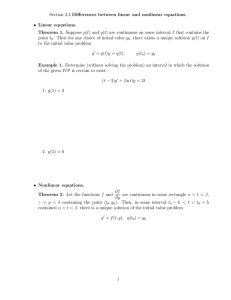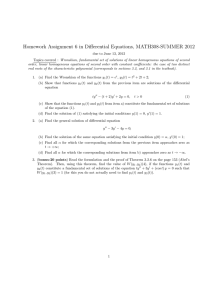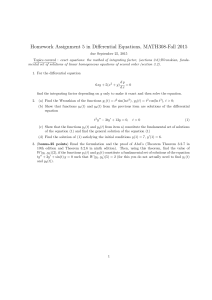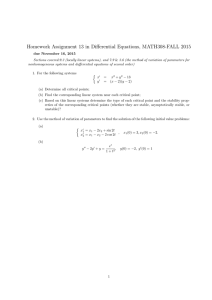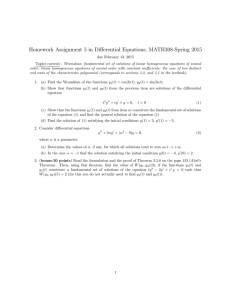A ORDINARY DIFFEINTIAL BY LYAPUNOV’S
advertisement
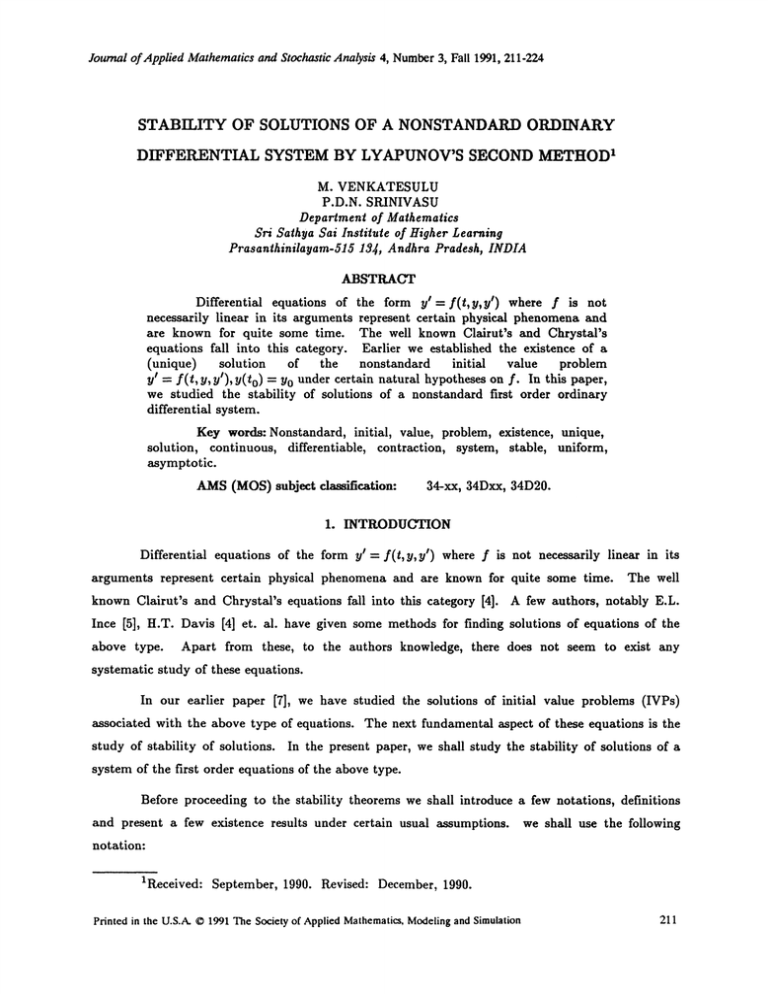
Journal of Applied Mathematics and Stochastic Analysis 4, Number 3, Fall 1991, 211-224
STABILITY OF SOLUTIONS OF A NONSTANDARD ORDINARY
DIFFEINTIAL SYSTEM BY LYAPUNOV’S SECOND METHOD a
M. VENKATESULU
P.D.N. SRINIVASU
Department of Mathematics
Sri Sathya Sai Institute of Higher Learning
Prasanthinilayam-$15 134, Andhra Pradesh, INDIA
Differential equations of the form y: =f(t,y,y ) where f is not
necessarily linear in its arguments represent certain physical phenomena and
are known for quite some time. The well known Clairut’s and Chrystal’s
equations fall into this category. Earlier we established the existence of a
(unique) solution of the nonstandard initial value problem
y = f(t, y, y), y(to) = Yo under certain natural hypotheses on f. In this paper,
we studied the stability of solutions of a nonstandard first order ordinary
differential system.
Key words: Nonstandard, initial, value, problem, existence, unique,
solution, continuous, differentiable, contraction, system, stable, uniform,
asymptotic.
AMS (MOS) subject classification:
34-xx, 34Dxx, 34D20.
1. INTRODUON
Differential equations of the form
y= f(t,y,y)
where
f
is not necessarily linear in its
arguments represent certain physical phenomena and are known for quite some time. The well
known Clairut’s and Chrystal’s equations fall into this category [4]. A few authors, notably E.L.
Inee [5], H.T. Davis [4] et. al. have given some methods for finding solutions of equations of the
above type. Apart from these, to the authors knowledge, there does not seem to exist any
systematic study of these equations.
In
our earlier paper
[7],
we have studied the solutions of initial value problems
(IVPs)
associated with the above type of equations. The next fundamental aspect of these equations is the
study of stability of solutions. In the present paper, we shall study the stability of solutions of a
system of the first order equations of the above type.
Before proceeding to the stability theorems we shall introduce a few notations, definitions
and present a few existence results under certain usual assumptions, we shall use the following
notation:
Received- September, 1990.
Revised: December, 1990.
Printed in the U.S.A. (C) 1991 The Society of Applied Mathematics, Modeling and Simulation
211
M. VENKATESULU AND P.D.N. SRINIVASU
212
X = [0,oo),
denotes the n-dimensional real space equipped with the box norm
I
=. I=1,
given by
where z = column(zl, Z2,...,zn) {5 R n,
s = {z R"lzl <_ c}, where c is a positive constant,
D is a connected subset of R n with the non empty interior,
A denotes the interior of a subset A of
C(J, R n) is the set of all continuous vector valued functions defined on a subinterval J of I
with values in R n,
and
y" denote the first and second order derivatives of y, respectively, if they exist.
V 1 x V 2 is the Cartesian product of two non-empty sets V1 and V2, taken in that order,
f(t, y, z) = column(f l(t, y, z), f2(t, y, z),..., fn(t, y, z)) is a vector valued not necessarily
linear function defined for (t,V, z) {5 1 x D x S with values in R n,
denotes
jth(j = 1, 2,..., n) component of a function g defined on I x D x S with values in
B- 1 is the inverse matrix of the matrix B, if it exists.
Consider the nonstandard initial value problem
where
(to, Yo) {5 1 x D
.
y’ : .f t, y, y’),
(I)
(o) = o
(2)
Problem (1), (2) will be denoted by NSTD IVP.
Definition 1: By a solution of NSTD IVP (1),(2) we mean a continuously differentiable
function V {5 C(J, Rn), where jr is some subinterval of I containing t0, such that
(i)
(to) = o,
(y(t), y’(t)) {5 D x S for all t {5
(ii)
and
(iii)
y’(t) = f(t,y(t),y’(t)) holds for all t {5 J.
We shall denote a solution of problem (1),(2) by y(t, to, Yo) instead of y(t).
Also, consider the (not necessarily linear) functional equation
Stability of Solutions of a Nonstandard Ordinary Differential Syston
-
213
z(-) f( ",YO -I- / z(s)ds, z(. )).
Definition
:
By
(Yo +
(ii’)
fto
to
a solution of equation
some subinterval of I containing
(3)
(3)
we mean a function z
C(J, Rn), where
jr is
to, such that
z(s)ds, z(t)) E D x S for all t E J
and
t
z(t) = f(t,yo +
(iii’)
/z(s)ds, z(t)) holds for all t
J.
to
The following result can be easily verified
(see [7]):
Result 1: IVP (1), (2) has a [unique] solution if equation
(3) has a [unique] solution.
Delinition 3: By a solution of system (1) we mean a continuously differentiable function
y C(J, Rn), where J is some subinterval of I, such that conditions (ii) and (iii) of Definition 1 are
true for t
J.
Definition 4: Let b(t) be a solution of system (1) existing on the interval I. We say that
(t) is a stable solution of system (1) if for every e > 0 and to I there exists a 5(to, e ) > 0 such that
where Yo E Do, then the solution y(t, to, Yo) exists for all t >_ to and
whenever 19o- (to) <
y(t, to, Yo)- ff(t) < e for t > to.
,
Let y(t) be an arbitrary solution of (1) existing on the interval [0, +oo). Substituting the
transformation
y=w+
into
(1) we get
w’ = g(t, w, w’)
where g(t, w, w t)
,
(4)
= f(t, w + q, w’ + ’) f(t, t).
We note that g(t, 0, 0) = 0, and that the stability of (t) is equivalent to the stability of the
zero solution (w(t) =_ 0) of system (4). For this reason, from now on we take D = {y e Rnlyl <_ b},
where b
>0
is a constant, little later we assume that
zero solution of
Let to
f(t, 0,0) = 0 and
we study the stability of the
(1).
I and Yo
DO (i.e., Y01 < b).
Assume that the function f satisfies the following
M. VENKATESULU AND P.D.N. SRINIVASU
214
conditions:
(x)
f(t,g,z) is continuous with respect to (t,y,z) E I D S,
f(,,z)
s for n (,,z)
9s
and
f(t,V,z) f(t, V2,z2) < k I y2l + k2lz z2l for all
(t, yl, Zl), (t, y2, Z2) G. I xDxS, where 1 0 and 0 2 < 1 are constants.
Then we have the following estence result:
:
If conditions (I)-(III) are satisfied then IVP (1), (2) h a unique mlution
esting on the interval J = It0 -a, t 0 + a] I, where is any real number such that
Resu
0
< a < rain((1 k2)lkl, (b-
o )/)-
Proof. Consider the Banaeh space C(J,R n) equipped with the supremum norm
II II
given
by
Ii z !1 =
,
t.J
zCt) I, e cCa, a").
Let M be the closed subset of C(J, R n) defined by
M = {z e C(J, n")l
I II -< }-
Denote by F the map on M defined by
t
(Fz)(t) = f(t,y0 +
/z(s)ds, z(t)),z
.
M and t e J.
to
(I)-(III), it is easy to see that F is a contraction on M and by the
contraction mapping theorem [6], F has a unique fLxed point in M. Hence by Result 1, IVP (1), (2)
Using conditions
has a unique solution existing on the interval J and the proof is complete.
The following corollary is an immediate consequence of Result 2:
Corollar
1. Let 0
for every Yo with
J = [t o a, to + ] f’l I,
< e < b be a constant and let conditions (I)- (III) be satisfied. Then
uol <_,, 1VP (1),(2) has a unique solution ezisting on the interval
where a is any real number, such that
0
< < rain((1- k2)lkl, (b--e)/c).
In other words, every IVP (1),(2) with
yol _< e has
(7)
a unique solution existing on the common
Stability of Solutions of a Nonstandard Ordinary Differential System
215
interval J.
The next result follows from condition
(IIl) and the Gronwall’s inequality [3], and
can be
easily established.
Re.salt 3: Let t o E I, and let Yo,’ o DO. Suppose that conditions (I)- (III) are true. If
the solution y(t, t o, Yo) and (t, to,’ o) exist on a common interval J then
k1
y(t, to, Z/o)-’ (t,to,o)1
<-luo ol eiLkzlt-tOI-
(8)
for all t E J l"
Now, suppose that f satisfies the following condition:
(xv)
f has all continuous partial derivatives upto order p with respect to (t, y,z) I x D S,
Of
<
17..I
where p > 1 is an integer, and
and 0
2
(J = 1,2,...,n), where
_< k 2 < 1 are constants.
Then, it is easy to verify that condition (IV) implies conditions (I) and (III), and hence we
have the following result:
:
Suppose that conditions (II) and (IV) are satisfied. Then IVP (1),(2) has a
unique solution y existing on the interval J = [to-a,to-t-a]I, where a is given by (6) with
k = k (i = 1,2). Moreover, y is p / 1 times continuously differentiable on J and
Re.sail
-Of i,
-Of
I Of
i)f,
"=(z-Cj)-(7+(j
where I is n x n identity matrix
Ofl
Oz x
Oz.
Of.
Of,
Oz 1
Oz n
(9)
M. VENKATESULU AND P.D.N. SRINIVASU
216
and
\j] is defined similarly.
Relation
(9) follows from the quotient
f(t -t- h, y(t + h), y"(t + h))- f(t, y(t), yt(t))
y’(t + h)- yt(t)
by applying the mean value theorem for vector valued functions on the right hand side function, by
making use of condition (IV) and, finally, by allowing h tend to zero.
2. STABILrI THEOREMS
Throughout this section, we assume that the function f satisfies conditions (II) and (IV)
and that f(t, O, O) = 0 for all t E I.
Consider the system
y’ = ft, y, y’).
(10)
Definition 5: We say that y(t) =_ 0 is a stable solution of (10) if for every e > 0 and any
t o e I there exists a 6(e, to) > 0 such that whenever [Y0[ < 6 then the solution y(t, to, Yo) exists for
all t >_ t o and [y(t, to, Yo) < e for all t > t0.
Definition
6: We say that y(t) =_ 0 is a uniformly stable solution of
(10) if
in Definition 5
is independent of to
Definition 7: We say that y(t) = 0 is an asymptotically stable solution of (10) if
(i)
y(t) =_ 0 is stable
and
there exists a
(ii)
6o(to)> 0
such that whenever
to zero as
Definition 8: We say that y(t)
(i)
and
(ii)
y(t)
-
0 is uniformly stable
-
yol <
then the solution y(t, to, Yo) tends
0 is an uniformly asymptotically stable solution of (10) if
there exists a 60 > 0 and for every e > 0 there exists a
T(e)> 0 such that whenever
Yo < 60 then y(t, to, Yo) < e for all t >_ to + T(e).
Note 1: We note that uniform [asymptotic] stability always implies [asymptotic] stability of
the zero solution of (10). Below, we shall see that the converse is also true if f is either periodic in t
or autonomous.
Stability of Solutions of a Nonstandard Ordinary Differential System
Theorem 1: Let f(t,y,z) be periodic in t
[asymptotically] stable then
it is uniformly
of period
w.
217
the zero solution
of (10)
is
[asymptotically] stable.
The theorem can be proved easily, using Result 3, along the same lines as of Theorems 7.3
and 7.4.
[8], and hence the proof will be omitted here.
Delinilion 9: We call
a real valued function
V(t,y,z), defined
on
I x D x S,
a
Lyapunov
function, if:
(i)
V(t,y,z) is continuous with respect to (t,y,z) E I xDxS
and
(it)
V(t, y, z) is continuously differentiable with respect to (t, y, z) E I x Do x S
.
Definition l&" We define the derivative of V(t,y,z) with respect to system (10) by
(it)
Note 2: Along a solution y of system (10), we have, by (9),
(,, (t), ’(t)) = v’(t, (,), ’(,)).
Definition 11: A real valued function a(r) defined
definite if at0) = 0 and a(r) > 0 for r E (0, b].
on the interval
[0,b]
is called positive
Now, we shall present few theorems for [uniform] stability and [uniform] asymptotic
stability of the zero solution of system (10).
(Stability o] the zero sol=ion ): Suppose that there erists a Lyapnnov function
V(t, y, z) defined on I x D x S satisfying the following conditions:
(i)
V(t, O, O)= 0 for all t E I,
there exists a continuous positive definite function a(r) defined on [0,b] satisfying
(it)
inequality a ( Y ) <_ v(t,y,) fo lt (t,y, ) z D x S h that z = .f(t,y,z)
Theorem
and
(iii)
V*(t,y,z) <_O for all (t,y,z) e lxDxS such that z = f(t,y,z).
Then the zero solution
of system (10)
is stable.
We note that for every (t,y) I x D, in view of conditions (II) and (IV), there exists
unique z S such that z = f(t,y,z).
a
M. VENKATESULU AND P.D.N. SRINIVASU
218
< < b and (k I/(I- k 2))e < c. From condition ( ) and from
the continuity of V, it follows that for every t o E I there exists a number 6o(to, e ) > 0 such that if
uol < ao( < e) and Iol < ( x/(1 u))ao, then
Proof: Let
be such that 0
V(to, Vo, Zo) < a(e).
(12)
By Corollary I, the solution y(t, to, go) exists initially on the interval [to, to + a], where
(7). We have, by condition (10), that
a is given by
Iience, from relation (12), we get that
V(to, V(to), v’(to)) <
IV(t, to, Vo) < e for all t
Claim:
For, if possible, let there exist a t I (to, to + a] such that Iv(t, to, Yo) = e. From condition
(iii) and note 2,
we get that
tt(t, y(t, to, Yo), y’(t, to, Yo)) < 0 for all t e [to, t1],
which upon integrating between t0 and t, gives that
v(, v(*, *o, ,o), v’(*, *o, Vo)) <_ V(*o, ,(*o), v’(*o)) < ,(*),
[to, tl].
for all t
Then from condition (ii) and inequality
(13),
(13)
we get that
() <_ v(t, v(t, to, Vo),V’(tx, to, Vo))
<_ V(*o, Vo, V’(*o)) <
which is a contradiction. Hence our claim is true.
Next, let
us denote the solution
y(t, to, Yo) by yl(t). Since Ivx(t0+a)l <e, again by
Corollary 1, the solution y(t,to +a, yl(t o +a))of the following initial value problem
v’ = ’(t,v,v’),V(to +,) = v(to + )
exists on the interval
[to, to + 2a].
If we denote y(t, to+a, Yl(to +c)) by
(8), that
for t t
Ito, to + 1,
y2(t), we have, by relation
Stability of Soh,tions of a Nonstandard Ordinary Differential System
219
and it can be shown as in the above that
(t) < e for an t e [to, to + 2a].
Again, since
y(t0 + 2a) < e, by Corollary 1, the solution y3(t) of the initial value problem
y’ = f(t, y,y’), y(t0 + 2a) = Y2(tO +
exists on the interval [to + a, to + 3a], and we have that
yz(t) = y2(t) for t
Y3(t) < e for all t e [to + a, to + 3a].
Proceeding in this way, indefinitely, we get a sequence of solutions {yn(t)} and if we define
,(t), t e [to, to +,1,
,,
u(t), t e [to + to + 2a ],
yn(t), t e [to + (-" 1)c, 0 +
then clearly y(t) is a unique solution of system (10) with y(to)= Yo" Moreover, y(t) exists on the
entire interval [to, + oo) and ly(t) < c for all t >_ to. This shows that the zero solution of (10) is
stable and the proof is complete.
Theorem
$
(Uniform stability
a the Nero solution):
Let condition (ii) in Theorem 2 be
replaced by the condition:
a(lYl ) _< W(t,y,z) < b(lYl) for art (t,y,z) I O S such that z = y(t,y,z), were a(r)
and b(r) are continuous, positive definite functions ad o [0,1.
(ii’)
Then the zero solution
of system (10)
is uniformly stable.
Proof: Let e be such that 0 < e < b and (k 1/(1- k 2))e < c. Choose a ()> 0 such that
b(5) < a(e) and < e. Now, let o E I and Yol < di. By Corollary 1, the solution y(t, to, Yo) exists
initially on the interval [to, t o + a], where a is given by (7).
M. VENKATESULU AND P.D.N. SRINIVASU
220
Claim:
(t, to, o) < for an t e [to, to + ].
For, if possible, let there exist a point t2 (to, to + a] such that I9(t2,to, Yo) = e. Since
]Yol < 6 < there exists a point t e (to, t2) such that y(t, to, Yo) = 5. Now, from condition (iii)
,
nd note 2, we get
(t, y(t, to, Yo), y’(t, t
o, Yo))
<- 0 for all t e [to, t2],
which upon integrating between t I and t2, gives that
V(t2,Y(t2,to, Yo), Yt(2,lo, Yo)) <- V(t,Y(t,to, Yo), Yt(,to, Yo))-
(14)
Then from condition (it t) and inequality (14), we get that
b(S) < a() _< V(h,v(, o, Vo), y
, o,
<_ v(h,y(*,*o, Vo),V’(*,*o, vo)) <_ b(),
which is a contradiction. Hence our claim is true.
Rest of the proof follows as in Theorem 2 and hence will be omitted.
(Asymptotic stability o the zero solution): Suppose that here exists a Lyapunov
function V(t, y, z) defined on I x D x S satisfying the following properties:
V(t, 0, 0) = 0 for all t e I,
(i)
a( V ) <_ v(t, v, z) fo tt (t, v, z) z x D x S such that z = f(t, V, z), where a(r) is a
(it)
Theorem
continuous, positive definite function defined on
and
[0,b]
V*(t,y,z)<_ -c(Ivl) for all (t,y,z) eIxOxS such that z=f(t,y,z), where c(r)
continuous, positive definite function defined on [0,hi.
(iii)
of (10)
Then fhe zero solution
is a
is asymptotically stable.
(10) follows from Theorem 2, and proof of existence of a
6o(t0) > 0 such that vol < implies that the solution y(t, to, Yo)-,O as t---,oo can be given along
the same lines as that of Theorem 8.5 [8] and hence will be omitted.
Stability of the zero solution of
o
Theorem 5 (Uniform asymptotic stability of the zero solgtion): Suppose that there eists a
Lyapunov function V(t,y,z) defined on I x D x S satisfying the following conditions:
a(
(i)
and
b(r)
are
) <_ v(t,y,z) <_ b( y for all (t,y,z) I x D x S such that z = f(t,y,z), where a(r)
continuous, positive definite functions defined on [0,b]
Y
and
(it)
V*(t,y,z)< -c(lYl) for art (t,y,z)IxDS such that
z= f(t,y,z), where
c(r)
is a
Stability of Solutions of a Nonstandard Ordinary Differential System
continuous, positive
221
definite function defined on [0,b].
Then the zero solution
of (10)
is uniformly asymptotically stable.
Proof: By Theorem 3, the zero solution of (10) is uniformly stable. Choose r/> 0 such that
and (T 1/(1 -T 2))r/< c. Then there exists a 5o > 0 such that if to I and Yol < 6o, then
to, Yo) < r/for all t _> to. Also for a given e > 0 with < r/, there exists a 6(e) > 0 such that if
I and Yo[ < then y(t, to, Yo) < e for all t _> to.
,
Let
]2 <_ r 5 b},
sup{b(r)
/2 <_ r <_ b},
>
M2
Ma = iny{a(r)
and
M3 = inf{c(r) 16/2 <_ r <_ b}.
Now, let
Clearly M > 0,(i= 1,2,3) and, from condition (ii), we have that M x <M R
T = (M2- M1)/M3 and note that T > 0 and depends only on e.
Claim: For every solution y(t, to, Yo) of (I0) such that to E I and
least one point t I E [to, to + T] such that y(tl, to, Yo) < 6.
lol < ao, there exists at
For, if possible, let there exist a solution y(t, to, Yo) of (10), for some to I and some Yo
with Yol < 6o, such that y(t, to, Yo)[ >- 6 for all t e [to, t o + T]. Then, there exists a > to + T
such that y(t, to, Yo) > 5/2 for all t [to,’ ). Now, from conditions (i) and (ii) and note 2, we
’
get that
M 1 <_ a(ly(t, to, yo) l) <_ v(t,y(t, to, Yo),y’(t, to, yo))
<- V(to, Yo, Yt(to))
M3(t to)
< b( Yo )- M3(t- to)
< M 2 M3(t to)
which implies that
t
to <
(M2 M1)/M3 = T for all t e [to,7 ),
which is certainly a contradiction. Hence our claim is true.
Thus, we have that if to E I and
yol < 60, then y(h, to, Yo) < 6 for some
[to, to + T] and consequently y(t, to, yo) < for all t >_ t o + T. The proof is complete.
M. VENKATESULU AND P.D.N. SRINIVASU
222
The following corollary follows immediately from Theorem 5.
(iit)
:
Let condition (ii) in Theorem 5 be replaced by
V*(t,y,z)_ -cV(t,u,z) for all(t,y,z) EIxDxS such thatz= f(t,y,z), where c > 0 is
Corollarj
a constant.
Then the zero solution
of (10)
is uniformly asymptotically stable.
3. EXAMPLES
In the study of free oscillations of positively damped systems,
differential equation [1]:
1.
,, + o +,(,)3(,,)
where w is a nonzero constant and 0
Equation
we encounter the following
= o,
(15)
< e < < 1.
(15) is equivalent to the system
y’ = f(t,y,y’)
(16)
where
and
Choose the constants b > 0 and e > 0 such that
3e <
11c4 and b < c(1- ec4)1(1 -b w2).
Let D = {y E R21 yl < b} and S = {z R21 z _< }. w
is defined on I x D x S and satisfies the following conditions:
y(t, 0, 0) =0,
A)
f(t, y, z) e S for (t, y, z) e I x D x S,
B)
f(t,y,z) is continuously differentiable with respect to (t,y,z)
C)
Of _< w2
Ib-x
Of _< 1, Of _< 3ec4 and Of _< 2ec 4.
Ib-b-
Ib-
Ib-
(7)
easily verify that
.
I xDxS, and
fCt, y, z)
Stability of Sohttions of a Nonstandard Ordinary Differential System
Thus
2
f
satisfies conditions
(H) and (IV)
on I xDxS with
l =maz(1,w)
223
and
= 34"
Now, consider the function V(t,,z) defined on IxDxS by
2"
Clearly, V is continuously differentiable on I x D x S and tisfi the followin conditions:
V(, O, O)=0,
(0
a(lul)V(t,y,z)b(]ul) for all (t,y,z) eIxDxS, where a(r)=ar2, b(r)=ar2,
(ii)
a = rain(l, w2), fl = max(l, w2)
and
for
,
(t, y, z) $ x D x S such that z = f(t, z).
Hence, by Theorem 3, the zero solution of (16) d hence of (15) is uniformly stable.
2. Let
sin
I,
7r/2 < y
i,
y
< -r/2.
Clearly, g is a continuously differentiable function on R,g(O)= O, yg(y)> 0 for y :/k 0 and
g(u) < 1.
Consider the equation
y’ =
where 0
(u)(o. )2,
(18)
< c _< 1/2. Let
D={yeRi
lYl <n’} and,.q’= {zeRI Izl
It is easy to verify that the function f(t, y, z) = -ag(y)(cos Z) 2 satisfies conditions (II) and
(IV) on IxDxS and f(t,0,0) =0 for all t E I. Now, consider V(t, y, z) defined on IxDx$ by
V(t,y,z)=y2. Clearly, V is continuously differentiable on IxDxS and satisfies the following
conditions:
M. VENKATESULU AND P.D.N. SRINIVASU
224
(i)
(ii)
a( V ) <_ V(t, V, z) _< b( Y
V(t, 0, 0) = 0 for all t I
and
(iii)
for all
(t, y, z) q I x D x S, where a(r) = b(r) = r2,
.
v*(t,v,z) = av =
(t, y, z) E I x D x q, where
NS
c(r) = 2arg(r)(cosl)
Hence, by Theorem 5, the zero solution of (18) is uniformly asymptotically stable.
ACKNOWLEDGEMENT
The authors are extremely grateful to the referee for the valuable and important suggestions
which resulted in the present form of the paper. The authors dedicate the paper to the Chancellor of
the Institute Bhagawan Sri Sathya Sai Baba.
PEFERENCES
Ali Hasan Nayfeh, "Problems in Perturbations", Wiley, New York,
(1985).
Bartle, R.G., "The Elements of Real Analysis", Wiley, New York, (1976).
[3]
Brauer, F. and Nohel, J.A., "The Qualitative Theory of Ordinary Differential Equations
An Introduction", W.A. Benjamin, New York, (1969).
Davis, H.T., "Introduction to Nonlinear Differential and Integral Equations", Dover
Publications, New York, (1962).
[5]
Ince, E.L., "Ordinary Differential Equations", Dover Publications, New York, (1956).
Krasnosel’skii, M.A., et. al., "Approximate Solution of Operator Equations", WoltersNoordhof Publishing, Groningen, (1972).
[7]
Venkatesulu, M. and Srinivasu, P.D.N., "Solutions of nonstandard initial value problems
for a first order ordinary differential equation", J. Appl. Math. Sire., Vol 2, No. 4,
(1989), 225-237.
Yoshizawa, T., "Stability Theory by yapnnov’s Second Method", The Mathematical
Society of Japan, Tokyo, (1966).

